|
Hair
Receivers,
Secret Beauty Aids of the Past
| By Mike McLeod
|
 |
Although rare today, the
hair receiver was a common fixture on the dressing tables of women
from Victorian times to the early decades of the 20th century. Its
purpose was to save hair culled from the hairbrush and comb, which
were used vigorously on a daily basis. The hair could then be
stuffed into pincushions or pillows. Since hair was not washed as
often as it is today, oils were frequently used to add scent and
shine to hair. The residual oil made the hair an ideal stuffing for
pincushions because it lubricated the pins, making it easier for
them to pierce material. Small pillows could be stuffed with hair,
which was less prickly than pinfeathers.
But possibly most
important, hair receivers made the creation of ratts possible. A
ratt (sometimes spelled rat) is a small ball of hair that was
inserted into a hairstyle to add volume and fullness. The ratt was
made by stuffing a sheer hairnet until it was about the size of a
potato and then sewing it shut.

|
|

|
|
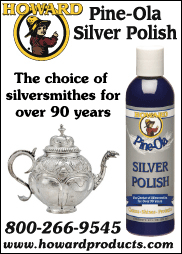
|
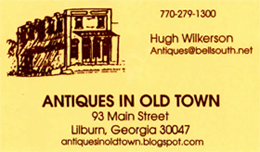
Contact
us to
place your antique
shop
or antique
related
information
here.
|
|
|
|
|

|
|
A favored hairstyle during
Victorian times parted the hair in the center and pulled it to the
sides. In photos from that era, it is easy to spot the women with
flat hair who were not using ratts and those with "big hair" who
were. One reason for favoring this hairstyle was it revealed as much
of the face as possible. In Renaissance times, a wide and high
forehead was a sign of virtue. This is why paintings from that era
often portray women with just a little hair showing around the face
and a big, wide forehead. Since Victorian women only used a little
face powder and no other make-up lest she be scandalized as a
"painted lady," much effort was invested in hairstyles and clothing
to maximize beauty.
Another reason for their
desire to display as much of the head as possible was that the
Victorians were swept up in the new, so-called "science" of
phrenology. This craze postulated that a person's qualities and
characteristics, both good and bad, could be determined by the
contours of one's head. Or as some people have called it, by
"reading the bumps on your head." This curious infatuation of the
Victorians is discussed below.
The Victorians were
extremely concerned with their appearances, and a woman's hair was
considered her crowning glory. In 1894, an article in The Delineator
magazine stated, "The often-admired 'crowning glory' may be rendered
almost a disfigurement if disposed unbecomingly, while a tasteful
and careful dressing of the tresses, even though they are not very
beautiful, will lend a decided charm to a plain face."
|
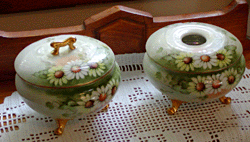
|
Usually
identified by the hole in the lid for inserting hair, hair
receivers graced the dressing tables of women from Victorian
times to the 1950s. (Photo courtesy of and from the personal
collection of Elza
Brokaw.) |
The use of wigs was common
at this time, for women and men (judges, magistrates, and even
soldiers wore wigs into battle). However, these were usually made
from someone else's hair. A woman could use a ratt to create a
beautiful hairstyle and truthfully answer that this was her own
hair.
The widespread use of
"extra hair" is evidenced by this instruction from Godey's Lady's
Book: "When a lady is in danger of drowning, raise her by the dress
and not by the hair, which oftentimes remains in the
grasp."
A hair receiver can be
identified by a finger-wide hole in the lid, through which hair is
poked. They can be round or square in shape, and some are footed.
Made of a variety of materials, including glass and in later times
celluloid, some of the prettiest examples are of porcelain. RS
Prussia manufactured beautiful hair receivers, and one with delicate
floral prints sold recently on eBay for $152. However, you will
usually see the finer antique hair receivers hovering in the $100
range, while most are well below that amount.
It is uncertain if Japanese
women also collected their spare hair for adornment, but Japanese
potters certainly created hair receivers. You can find Nippon,
Kutani and Sumida hair receivers.
While some say that hair
saved in receivers was also used for hair jewelry, love tokens, and
mourning mementos, Lori Verge, curator of the Surratt House Museum
in Clinton, Maryland, states those items required straight, not
tangled hair. She believes that women used cut hair (rather than
combed out hair) for those purposes. Ms. Verge also reports that her
grandmother used a hair receiver as late as the 1950s.
Frantic about
Phrenology
The underlying premise of phrenology was that
individual characteristics or qualities resided in specific areas of
the brain. The strong traits in a person would cause specific areas
of the brain to be larger than others, and the shape of the skull
would be altered, thus causing mounds or bumps.
A trained phrenologist
supposedly could define your character by rubbing his hands over
your head to find those indicative bumps. Among the Victorians, this
was viewed as a predictor of your future, like palm reading. One old
photo from the day showed a phrenologist set up on a sidewalk in
front of a store with a client sitting in a barber-style chair,
ready to have his head read.
For a while, phrenology was
taken very seriously. Employers could require a potential employee
to get a reading from a phrenologist to verify honesty, diligence
and a willingness to work hard. Phrenologists also acted as
matchmakers and career counselors. Experts in the fields of
education and criminology consulted phrenologists.
Phrenologists used models
of the head or drawings to help them determine where to find
specific qualities. You can still happen upon these models of
diagrammed head in antiques shops from time to time. Some of the
Phrenological Areas of the Brain included: language, parental love,
fidelity, musical talent, valor, arithmetic, murder, mechanical
skill, cunning, larceny, pride, arrogance, wit, ambition and vanity,
poetic ability, compassion, belief in God and religion, memory, and
perseverance.
While we may find amusement
in this, some of the principles of phrenology have been proven
correct. It has been proven that certain areas of the brain do
control specific functions. We know this because people lose
specific abilities (speech, muscle control, etc.) after a stroke. In
addition, parts of the brain that are used more often do become
larger. And no one gives a second thought when someone says they are
"left-brained" or "right-brained."
Although phrenology might
be considered an early pioneering effort in the field of neurology,
its diagram of characteristics was severely flawed. In fact, all of
the qualities it assigned to specific areas of the brain were wrong,
except one. And that one was reassigned in later diagrams to the
wrong area.
Despite efforts by the
leaders of this movement, phrenology never attained the status of an
official science, and it has all but disappeared into the mists of
time.
However, hair receivers can
still be found today and are still quite collectable. When you are
treasure hunting, keep an eye out for these quaint curiosities of a
by-gone age.
2002
|
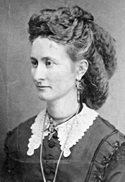
Does she or
doesn't she...
use hair ratts? (All photos from
the personal
collection of
Marna Jean and Doug Davis, http://www.shootingstarhistory.com/.)
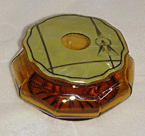
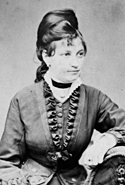
Because little
or no make-up was used, hairstyles (and "big hair") became extremely
important.
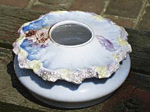
This R.S.
Prussia hair receiver
sold on eBay for $152.
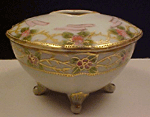
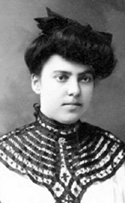
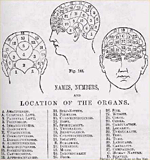
An 1848
phrenology chart
identifying trait in the brain.
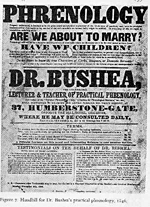
Handbill
advertising phrenology,
the "science" of reading the
bumps on the
head. |